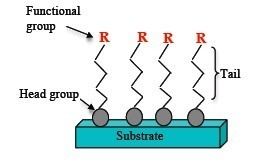 | ||
A chemically modified electrode (CME) is an electrical conductor (material that has the ability to transfer electricity) that has its surface modified for different electrochemical functions. CMEs are modified using advanced approaches to electrode systems by adding a thin film or layer of certain chemicals to change properties of the conductor according to its targeted function.
Contents
- Description
- Purpose of developing CMEs
- Applications of Chemically Modified Electrodes
- Approaches to chemically modify electrodes
- References
At a modified electrode, an oxidation-reduction substance accomplishes electrocatalysis by transferring electrons from the electrode to a reactant, or a reaction substrate.
Modifying electrodes' surfaces has been one of the most active areas of research interest in electrochemistry since 1979, providing control over how electrodes interacts with their environments.
Description
Chemically modified electrodes are different from other types of electrodes as they have a molecular monolayer or micrometers-thick layers of film made from a certain chemical (depending on the function of the electrode). The thin film is coated on the surface of the electrode. The outcome would be a modified electrode with special new chemical properties in terms of physical, chemical, electrochemical, optical, electrical, transport, and other useful properties.
CMEs and electrodes in general heavily depend on electron transport: A general term for electrochemical processes where the charge transports through the chemical films to the electrode. The term coverage is used to express the area-normalized in mol/m^2 of a specific type of chemical site in the thin chemical film in on the surface of the chemically modified electrode.
Purpose of developing CMEs
Advancements in investigations in the field of electrochemical science kept getting more thorough until scientists in the field found no use of bare surfaces to continue their investigations. The reason behind that is that researches that involved electrodes required certain chemical and physical properties that did not naturally exist in the materials used as electrical conductors. To work their way out of the dilemma, they used chemical modification to tailor the materials they used. Atoms, molecules, and nano particles are attached to the surface of materials to modify their electronic and structural properties, leading to changing their functionality.
Applications of Chemically Modified Electrodes
In their first stages, CMEs were merely applied in technologies they were initially made for (tuning surfaces for electrochemical investigations). After that, CMEs provided powerful routes to tune the performance of electrodes. The modification of electrodes facilitated the following processes in electroanalytical chemistry:
It also provided a route for other purposes, such as:
The research fields where CMEs are used include the following:
Approaches to chemically modify electrodes
The surface of electrodes can be modified in the following ways:
This method includes removing chemical species (substrate) from self-assembled monolayers (SAMs) to allow adsorbing molecules on the electrode surface independently of the original substrate structure. The polymer films can be organic, organometallic or inorganic, and it can either contain the chemical modifier or have the chemical added to the polymer in a latter process.
Carbon paste, glassy carbon paste, glassy carbon etc. electrodes when modified are termed as chemically modified electrodes. Chemically modified electrodes have been employed for the analysis of organic and inorganic species.
